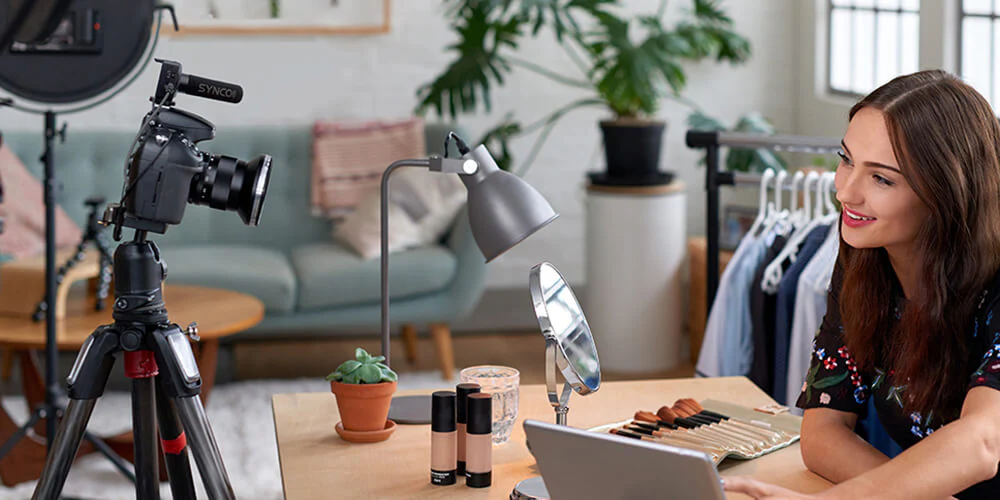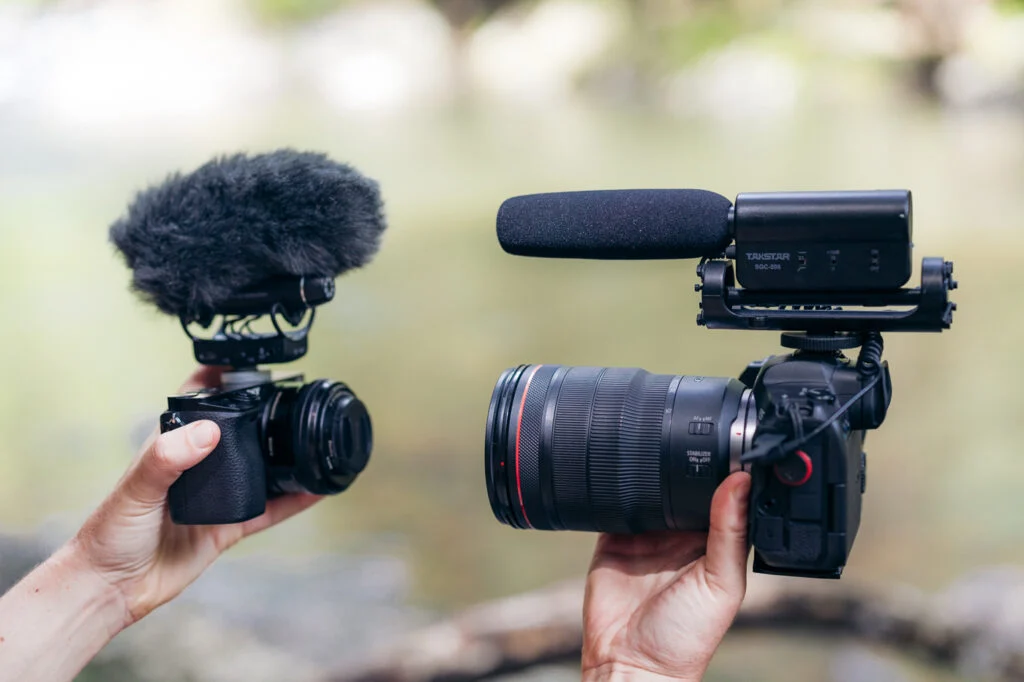Table of Contents
Introduction:
In the dynamic world of videography, the importance of high-quality audio cannot be overstated. While DSLR cameras have become increasingly popular for capturing stunning visuals, their built-in microphones often fall short in delivering professional-grade audio. This is where External microphones for DSLRs come into play, offering videographers a powerful tool to elevate the overall quality of their videos. In this comprehensive guide, we will delve into the world of DSLR external microphones, exploring their significance, types, features, and how they can transform your filmmaking endeavors.
Understanding the Limitations of Built-in DSLR Microphones:

Before delving into the benefits of External microphones, it’s essential to understand the limitations of built-in DSLR microphones. Most DSLR cameras are equipped with omnidirectional microphones, which capture audio from all directions. While suitable for capturing ambient sound, these built-in microphones often fail to provide clear, focused audio capture, especially in noisy environments or when the subject is at a distance from the camera. Additionally, built-in microphones are susceptible to picking up unwanted background noise, resulting in subpar audio quality.
Types of External Microphones for DSLRs:
External microphones for DSLRs come in various types, each designed to suit different shooting scenarios and preferences. The most common types include shotgun microphones, lavalier (lapel) microphones, and handheld microphones.
Shotgun Microphones:
Shotgun microphones are highly directional microphones designed to capture audio from a specific direction while minimizing background noise.
They are ideal for capturing dialogue, interviews, and sound effects in a controlled environment.
Shotgun microphones typically mount on the DSLR camera’s hot shoe or connect via a boom pole for greater flexibility in positioning.
Moreover, external microphones empower creators with greater control over their audio recordings. Many microphones feature adjustable gain settings, polar patterns, and frequency response options, giving users the flexibility to fine-tune their sound according to their preferences. Whether you’re aiming for a tight cardioid pattern to isolate vocals or a wide omnidirectional pattern to capture ambient sounds, external microphones offer the versatility and control necessary to achieve professional-grade results.
Beyond improved sound quality and versatility, external microphones also contribute to a more immersive and engaging listening experience for audiences. Whether you’re producing educational content, immersive storytelling, or cinematic productions, high-quality audio enhances the overall viewing experience, captivating audiences and leaving a lasting impression.
Lavalier Microphones:
Lavalier microphones are small, clip-on microphones that attach directly to the subject’s clothing, typically near the collar or neckline.
They offer hands-free operation and are commonly used for interviews, presentations, and documentary filmmaking.
Lavalier microphones provide close-mic’d audio capture, resulting in clear and consistent sound quality, even when the subject is moving.
Handheld Microphones:
Handheld microphones are versatile microphones commonly used in ENG (Electronic News Gathering) and live event coverage.
They offer excellent sound quality and are ideal for capturing interviews, performances, and on-location reporting.
Handheld microphones come in wired and wireless variants, providing flexibility in movement and positioning.
Features to Consider When Choosing an External Microphone:
When selecting an external microphone for your DSLR, several key features should be taken into consideration to ensure compatibility, functionality, and suitability for your specific needs. These features include:
Directionality:
The directionality of a microphone determines its ability to capture audio from a specific direction while rejecting unwanted noise.
Directional microphones, such as shotgun microphones, are preferred for capturing focused audio in noisy environments, while omnidirectional microphones offer a more natural sound pickup.
Frequency Response:
The frequency response of a microphone refers to its ability to capture a range of frequencies, from low to high.
A microphone with a flat frequency response reproduces audio accurately across the entire frequency spectrum, making it suitable for capturing natural-sounding vocals and ambient noise.
Connectivity:
External microphones for DSLRs typically connect to the camera via a 3.5mm TRS (Tip-Ring-Sleeve) or XLR (eXtended Low Range) connection.
It’s essential to ensure compatibility between the microphone and the DSLR camera’s input jack to avoid connectivity issues.
Power Source:
External microphones may be powered by various sources, including battery, phantom power (via XLR connection), or the camera’s plug-in power.
Consider the microphone’s power requirements and battery life to ensure uninterrupted recording sessions.
Mounting Options:

Different microphones offer various mounting options, including hot shoe mounts, boom pole mounts, and clip-on attachments.
Choose a microphone with mounting options that best suit your shooting style and preferences.
Benefits of External Microphones for DSLRs:
Investing in an external microphone for your DSLR offers a myriad of benefits that can significantly enhance the audio quality and overall production value of your videos:
Improved Audio Quality:
External microphones capture clearer, more focused audio compared to built-in DSLR microphones, resulting in professional-grade sound recordings.
By minimizing background noise and unwanted sound sources, external microphones ensure that your audio is crisp, intelligible, and immersive.
External microphones are indispensable tools for anyone serious about audio recording and content creation. From podcasters and filmmakers to musicians and educators, the benefits of using external microphones are undeniable. By investing in a quality external microphone tailored to your specific needs, you can elevate your audio recordings to professional standards, captivate your audience, and make a lasting impact in the digital world.
Enhanced Flexibility and Versatility:
External microphones provide videographers with greater flexibility and versatility in capturing audio in various shooting scenarios.
Whether you’re shooting interviews, documentaries, vlogs, or narrative films, external microphones offer tailored solutions to meet your specific audio requirements.
Professional-Level Sound Capture:
With the right external microphone, you can achieve professional-level sound capture that rivals that of high-end audio recording equipment.
External microphones excel in capturing nuanced sound details, allowing you to create immersive audio experiences that complement your visual storytelling.
In today’s digital age, where content creation and communication thrive, audio quality plays a crucial role in delivering a message effectively. Whether you’re recording podcasts, conducting virtual meetings, filming vlogs, or live streaming, the clarity and richness of your audio can significantly impact audience engagement and comprehension. While built-in microphones on devices have improved over the years, they often fall short in delivering the professional-grade audio necessary for high-quality content. This is where external microphones come into play, offering a plethora of benefits that elevate the audio recording experience to the next level.
Reduction of Post-Production Work:
Clear and well-captured audio from External microphones minimizes the need for extensive audio editing and post-production work.
By capturing high-quality audio during the recording process, you can streamline your editing workflow and focus on refining other aspects of your video production.
Enhanced Audience Engagement:
High-quality audio is essential for engaging and retaining the attention of your audience.
By investing in an external microphone, you can ensure that your videos deliver a superior audiovisual experience that captivates viewers and leaves a lasting impression.
Tips for Using External Microphones Effectively:
To maximize the performance of your external microphone and achieve optimal audio quality, consider the following tips:
The Right Microphone for the Job:
Select a microphone that is well-suited to the specific shooting scenario and audio requirements of your project.
Consider factors such as directionality, frequency response, and mounting options to ensure compatibility and functionality.
First and foremost, external microphones provide superior sound quality compared to built-in microphones. They are engineered with advanced technologies such as high-quality condenser capsules, superior preamps, and noise-canceling features, resulting in clearer, more detailed audio reproduction. Whether you’re capturing vocals, musical instruments, or ambient sounds, an external microphone can faithfully capture the nuances and subtleties, ensuring a professional-grade audio output.
Pay Attention to Mic Placement:
Proper mic placement is crucial for capturing clear and balanced audio.
Position the microphone close to the sound source while minimizing background noise and unwanted reflections.
Conclusion:
External microphones for DSLRs offer videographers a powerful tool to enhance the audio quality and overall production value of their videos. By providing clearer, more focused audio capture and greater flexibility in recording, external microphones enable videographers to create professional-grade content that engages and captivates audiences. Whether you’re shooting interviews, documentaries
Furthermore, external microphones offer versatility and customization options to suit various recording scenarios. With a wide range of microphone types available, including dynamic, condenser, shotgun, and lapel microphones, content creators can choose the perfect microphone tailored to their specific needs. For instance, dynamic microphones excel in capturing loud sound sources with minimal background noise, making them ideal for live performances and interviews. On the other hand, condenser microphones are renowned for their sensitivity and accuracy, making them preferred choices for studio recordings and podcasting.
In addition to microphone types, external microphones also come with various connectivity options, allowing seamless integration with different devices. Whether you’re using a DSLR camera, smartphone, laptop, or audio interface, there’s a compatible external microphone available to enhance your recording setup. This versatility enables content creators to record high-quality audio across multiple platforms without compromising convenience or performance.
Pleace click this keyword Mindmeister
For More Information Please Visit This Website Mindmeister
Pingback: Maximizing Creativity and Efficiency Unleashing the Power of MindMeister - Mindmeister